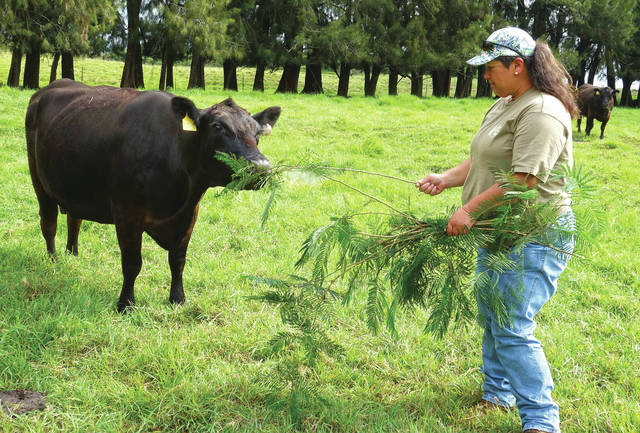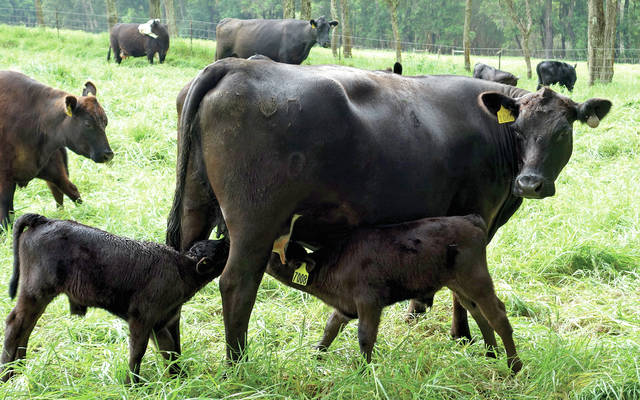Till the cows come home: Mealani Experiment Station provides valuable cattle grazing and genetics research
WAIMEA — Since March 26, Marla Fergerstrom has spent the vast majority of her time checking expecting cows and helping with their births.
Such tasks aren’t expected to lighten up anytime soon.
“We have 40 more cows still to give birth between now and mid-May,” she said last Wednesday. “We have 36 calves so far. There’s never a dull moment.”
Unlike ranchers, Fergerstrom’s work is scientific. With nearly 29 years’ experience at Mealani Experiment Station, she leads a team of four as the agriculture research technician there. Fergerstrom earned a bachelor’s degree in agriculture with an emphasis on animal science from UH-Hilo.
On a typical spring day, she can be found maneuvering a buggy through several gates to reach the farthest pen where all of the mother cows and their calves are kept, including one with a set of twins.
A symphony of loud mooing sounds can be heard throughout the pasture. This is nothing new to Fergerstrom, as third-generation Waimea Hawaiian Homes rancher.
“The mothers are calling the babies and the babies are calling back to them,” she said. “The animals are identified by a number. The girl calves’ numbers are on their right ears and boys on the left. They will nurse with their mothers until November.”
A few of the cows have names, such as Bullwinkle.
“She is 4 and has given birth three times,” Fergerstrom said. “She is pretty big framed and intimidating, like the cartoon character.”
As a special treat for the new mothers, she picks branches from leucaena trees.
“She’s done (letting the calves nurse), and thinking ‘I have to go make more milk so I’m gonna chew my cud now,’” Fergerstrom said.
This time of year, she and her team focus on the health and well-being of the cows Monday through Friday and on weekends, as needed. Each day can have its own challenge.
“A lot of times if a cow gives birth to twins, and it’s a male and a female, they are in two different sacks. So she’ll give birth to one, clean it, nurse it and then go off grazing. Then her body will tell her it has another baby so she’ll do it all again. But a lot of times she won’t accept the first one, so we have to nurse that calf (with her milk). It usually takes three to four days and then when she smells her milk through its pores she will let it nurse because both calves smell the same.”
An extension service of University of Hawaii-Manoa’s College of Tropical Agriculture and Human Resources, the MES facility opened in the mid-1960s. The entrance is visible from Mamalahoa Highway and leads to 196 acres of pasture land on the wet side of Waimea.
“The calves that are born here are used for the grazing project or genetics work,” Fergerstrom said.
More than 170 cows, calves, bulls, steers and heifer can be found in their herd. Through the years MES has reverted back to the Angus line to produce animals that perform best on grass for feed efficiency, growth and production.
“As part of the breeding project, Mike DuPont has been doing our selection of bulls that we use for the artificial insemination segment of our breeding season,” she said. “We’ve started to incorporate the use of genetic testing called HD50K. This program allows us to see the ability of our animals to be good sires, as well as for production in the grass-finish industry. We’ve had favorable results since it started in 2009.”
The bulls’ birth weight, ranking and EPD (expected progeny difference) — an animal’s genetic worth as a parent — are compared.
“It’s what that sire would pass on to his offspring,” Fergerstrom said. “We utilize that info to make sure we have a bull that has a really good ranking. We’re trying to look for smaller birth weights and something that has a good calving ease — the ability to give birth on its own.”
A principle investigator from UH-Manoa designs each MES project. Fergerstrom then discusses with them the availability of resources, implementation and data collection.
“The researchers provide recommendations, do site visits, and in May Dr. Mark Thorne has a grazing workshop for ranchers here,” she said.
There are eight research stations on Hawaii Island, as close as Lalamilo — where chickpeas are studied — as well as Volcano, Mauna Kea, Kona, Malama-ki, Waiakea, Komokana, and Hamakua — where they focus on koa selection.
Students from UH-Hilo and UH-Manoa visit MES each June for a one-week class on artificial insemination.
“During the first few days it involves handling of the reproductive tracts and a tank. Then on Thursday they do the real thing,” Fergerstrom said. “Cows usually do this 45 days or so after giving birth.”
Some students then go on to masters programs and vet schools.
Once cows at MES reach 10 years of age they are sold to local ranchers.
“Any surplus animals from the station are offered for a sealed bid at an annual sale in November,” Fergerstrom said. “The rancher or any interested party is allowed to come and view the bulls, 10-year-old cows, open cows and any wean offs we may have that are for sale. There are a few ranches that are repeat buyers in Kona, Hilo, Hamakua and Waimea.”
The program has a state budget but operations for the livestock is maintained through the sales of their commodities.
“We’re self-sufficient on the livestock side for supplies,” she said.
Other focuses at the research facility are soil and crops such as tea, protea, leucaena and blueberries grown and studied on property.
“The soil used on the experiment acreage is maile. It’s found naturally in this area,” Fergerstrom said. “It’s a different class of soil. It grows a lot of different varieties of crops.”
Fergerstrom’s favorite part of the job is being able to help the ag industry.
“It’s great being a part of this industry, providing services that people are happy to receive,” she said. “The biggest reward is having favorable responses from people that buy animals here and come back saying they are very pleased. To me that is a reward because it shows our efforts are recognized. It’s not only our efforts here, but everyone that’s involved with CTAHR, or affiliated with the work done here.”




